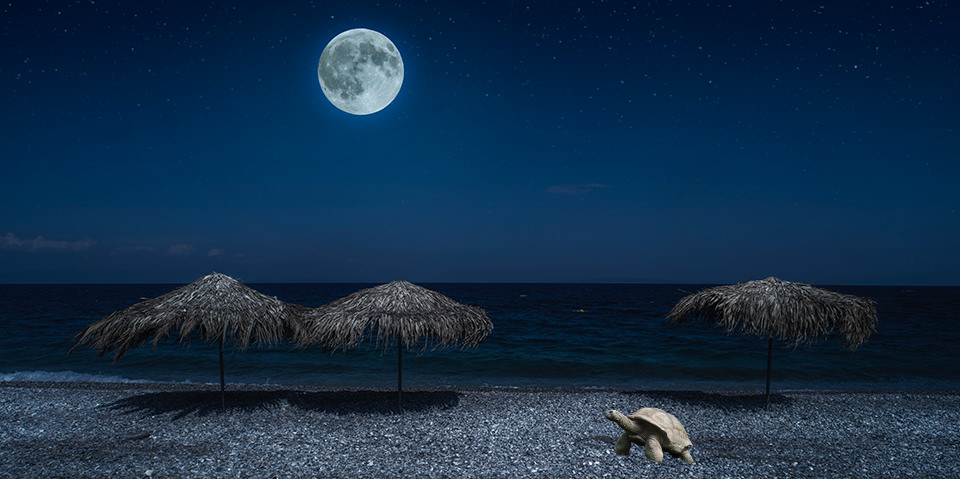
We have known the reasons for utilizing the sea turtle and wildlife friendly lighting in last post. Sea turtle friendly lighting is beneficial for wildlife, environment, and the owner of the beach. But how to achieve the sea turtle and wildlife friendly lighting? Must we prohibit the light at night to ensure the normal behaviour and increase the chance of survival for sea turtles?
Fortunately, we don’t need to turn off all lights at night all year round. The key to achieve the sea turtle friendly lighting is the management of artificial light. From managing the artificial light, we can minimize the negative effects on sea turtles as well as meeting the basic requirement of human safety at night.
Let’s start it.
Considerations for scheduling sea turtle friendly lighting
When you plan to install new lights for your beach or retrofit existing lighting system to sea turtle friendly and wildlife lighting, consider following questions:
- Is the light visible from the beach?
- Will the lighting fixture illuminate the beach?
- Are these lighting fixtures are necessary for the safety of pedestrians?
- Does the lighting fixture only emit light to one direction or broadcast the light to a wide range?
- Is the light too intense for wildlife?
- Is there a reflective surface which will reflect the light the beach around the lighting fixture?
Tips for reaching sea turtle friendly lighting
From asking former questions, you may have a better understanding of management of a sea turtle friendly lighting. Here are some tips to help you achieve the sea turtle friendly lighting. In simple words, the key for protecting sea turtles and wildlife from light pollution is to keep the light away from sea turtle habitats.
Use as few lights as possible, but ensure human safety
The main reason for adding lighting fixtures at night is to improve human visibility and safety. Lighting fixtures that do not matter the safety should be removed. For example, decorative lighting will not only cause light pollution but also increase the cost of energy and maintaining. Thus, we should place the lighting fixtures only where it is necessary. The minimized amount of lighting fixtures can reduce the risk of light trespass to sea turtles.
Use full-cutoff and fully shielded lighting fixtures
Full-cutoff light means the light will only downward to the ground, rather than upward to the sky. A fully shielded lighting fixture has a cap on the top of the fixture to prevent the uplight. Both of them are designed to eliminate uplight. Lighting fixtures for outdoor areas, such as parking lots and roadways shall be full-cutoff and fully shielded. This reduces the possibility of disturbing wildlife’s circadian rhythms. In addition, full cut-off and fully shielded light fixtures benefits human safety because the light is directed on the ground. Since the light is downward and directed on the ground, there is an increase in brightness to the human activity rang, while there is no impact on the beach.
Reduce the mounted height
Sometimes, using the full-cutoff and fully shielded lighting fixtures may fail to keep the light off the beach. High mounted lights can be visible even from a great distance of the beach. At this point, reducing the mounted height can be a good solution. It is especially effective when there is a dune, tall plants, or other structures between the beach and lighting fixtures. If the dune, plants, and other objects are taller than the lighting fixtures, they can block and shield the light from illuminating the beach. Since the light is not visible on the beach, effects of artificial lights on sea turtles are reduced.
Reduce duration of lighting
Some lighting fixtures are on throughout the night. However, leaving the lights on all night can consume a lot of electricity. Keeping lights on during the period which has low, or even no activity is just a waste of money. Turn off the light when there is no need for human safety. We should also pay attention to the nesting and hatching seasons of sea turtles. These periods are critical for the propagation of sea turtles. Turn off the lights and reduce lighting duration during nesting and hatching season is effective for decreasing negative lighting effects on sea turtles.
Use smart light control
The coastal areas are of large size. Controlling the lighting fixtures manually is not practical. Using smart light control is a good option to achieve sea turtle and wildlife friendly lighting. Smart light control is able to control the light intensity and duration automatically. Lower light intensity is beneficial for sea turtles. Smart light control works with sensors, such as photo sensor and motion sensor. Sensors are capable of detecting variations in light intensity and motions. Setting different light intensities in different period contribute to save energy cost. For example, you can set the light automatically on after dusk with full light intensity. Then, reduce the light intensity or turn off the light in the depth of the night. You can also set different light intensities based on detected motions.
Related video:












